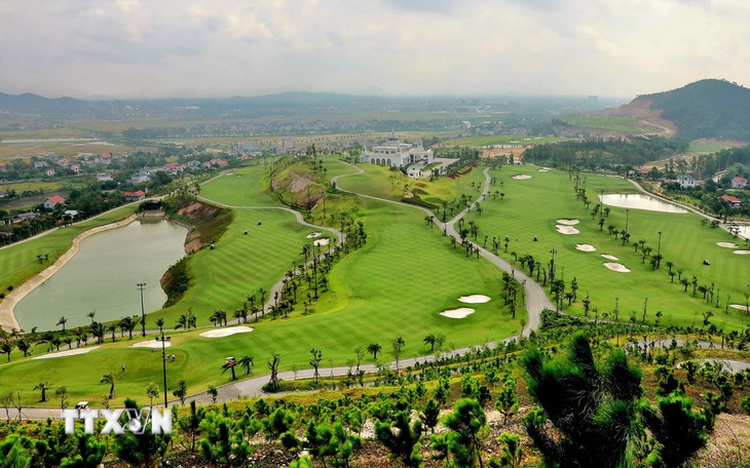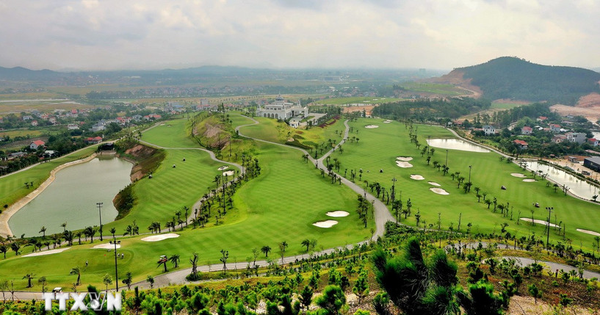
A corner of a golf course in Bac Ninh Province, northern Vietnam. Photo: Vietnam News Agency
Golf tourism is emerging as a bright spot in Vietnam’s tourism industry, contributing an increasingly significant share to the sector’s total revenue.
With over 80 internationally standardized golf courses, golf tourism is positioned as a strategic product to attract high-end travelers and elevate Vietnam’s status on the global tourism map.
Leading golf destination in Asia
Vietnam is hailed as Asia’s ‘golf paradise’ thanks to its diverse terrain, long coastline with world-renowned beaches, and majestic mountains.
Its mild tropical climate and year-round sunshine provide ideal conditions for developing golf tourism.
Notable golf courses in the country include The Bluffs Grand Ho Tram Strip, ranked among the world’s top 100 golf courses, Laguna Lang Co, Hoiana Shores Golf Club, and Ba Na Hills Golf Club, which have become favorite destinations for millions of international golfers each year.
According to the Vietnam National Authority of Tourism, golf tourism is one of the fastest-growing segments, with spending by golf tourists being six times higher than that by regular tourists.
Golf tourism not only brings substantial economic value but also enhances the image of Vietnam as a destination for premium, sustainable travel.
Vietnam’s reputation in the golf world has been recognized through a series of prestigious international awards.
For eight consecutive years from 2017 to 2024, Vietnam has been named ‘Asia’s Best Golf Destination’ by the World Golf Awards, and twice received the title of ‘World’s Best Golf Destination’ in 2019 and 2021.
Hanoi has also made its mark on the global golf map, being awarded the ‘World’s Best Golf City Destination’ title in 2023 and 2024.
Nguyen Trung Khanh, director general of the Vietnam National Authority of Tourism, said these accolades reflect the tremendous potential and clear competitive advantage of Vietnamese golf tourism.
He believes Vietnam is fully capable of hosting international golf tournaments and meeting the high standards of luxury travelers, including those from demanding markets.
Golf tourism is not only a premium sport activity but also the driving force behind the development of a high-class tourism ecosystem — from course infrastructure, hotels, and accommodation to fine dining and five-star services.
It is one of the strategic tourism products that Vietnam aims to develop, targeting international markets such as South Korea, Japan, the United States, Europe, and the Middle East.
As part of the strategy to promote Vietnam’s golf tourism, in July 2025, the Ministry of Culture, Sports, and Tourism appointed global golf legend Gregory John Norman (Greg Norman) as Vietnam’s tourism ambassador for the 2025–30 term.
According to Deputy Minister of Culture, Sports, and Tourism Ho An Phong, Greg Norman’s global influence makes him a fitting representative to bring Vietnam, especially its golf tourism, closer to the world.
During his new term, the ambassador will engage in various international promotional activities, focusing on attracting high-end travelers to Vietnam starting in 2025 and in the years to come.
Diversify golf tourism products
Vietnamese localities are spending efforts diversifying golf tourism offerings. A standout example is Hanoi, which is emerging as a key destination on Vietnam’s golf map.
Within a 60km radius of Hanoi’s center, there are more than 10 international-standard golf courses, including BRG Legend Hill, Sky Lake, Van Tri, FLC Golf Club Hanoi, and Long Bien Golf Course.

Vietnam is witnessing a strong transformation at the local level in investing in, developing, and diversifying golf tourism products. Photo: Vietnam News Agency
In addition to investing in course quality, Hanoi is expanding its offerings with premium accommodations, diverse cuisine, and culture-history-golf combo tours.
Experiences like ‘playing golf – exploring the Old Quarter – enjoying street food – relaxing with spa treatments’ are increasingly favored by high-end tourists.
Not only Hanoi but provinces in the Central Highlands and central coast regions are also actively tapping into golf tourism potential.
Following an administrative boundary expansion in July, Gia Lai Province has developed golf products that blend with eco and cultural tourism.
The province is currently hosting the 2025 National Golf Championship – VinFast Cup at FLC Golf Links Quy Nhon, using the event as a springboard to elevate its regional golf tourism profile.
Nguyen Pham Kien Trung, permanent vice-chairman of the Binh Dinh Tourism Association in Gia Lai, stated that golf-tourism integration is creating a stable flow of high-end travelers, generating substantial economic value and boosting investment.
Recently, a South Korean enterprise proposed building two international golf resort complexes in Gia Lai, covering 550 hectares with a total investment of $60 million.
In neighboring Dak Lak Province, local authorities are reviewing a project to develop a golf course and villa complex covering 110 hectares at the Ea Kao Lake area.
However, to truly establish golf tourism as a flagship product, Vietnam still has work to do.
According to Ha Van Sieu, deputy director general of the Vietnam National Authority of Tourism, golf tourism currently lacks products that connect cultural and nature-based experiences, remains fragmented from traditional tour routes, and has yet to fully capitalize on synergies with MICE (meetings, incentives, conferences, and exhibitions) tourism or long-stay vacations.
Additionally, connections between travel companies and golf courses remain weak, with a lack of coordination in building a complete service ecosystem.
Most visitors come just to play golf and are rarely introduced to products showcasing local cultural identity.
To address this, tourism experts suggested forming alliances among golf enterprises to build regional golf tourism brands, and to develop integrated, professional, and distinctive services.
Vietnam needs to host more international golf tournaments featuring famous players to effectively promote destinations globally.
It should develop specialized tours that combine high-end services such as golf–spa–fine dining for business travelers, or golf–culture–craft village packages to deepen experiences and attract those interested in local heritage.
Under Vietnam’s tourism development strategy to 2030, golf tourism is one of the key products to enhance national competitiveness, targeting high-end markets and sustainable growth.
With its natural advantages, improving infrastructure, and strong engagement across the tourism, sports, and investment sectors, Vietnam’s golf tourism stands at the threshold to solidify its place on the world golf map.
However, achieving long-term sustainability will require a comprehensive strategy to diversify the golf tourism ecosystem, with a focus on premium customer experiences to elevate Vietnam’s brand and position in both regional and global tourism markets.







